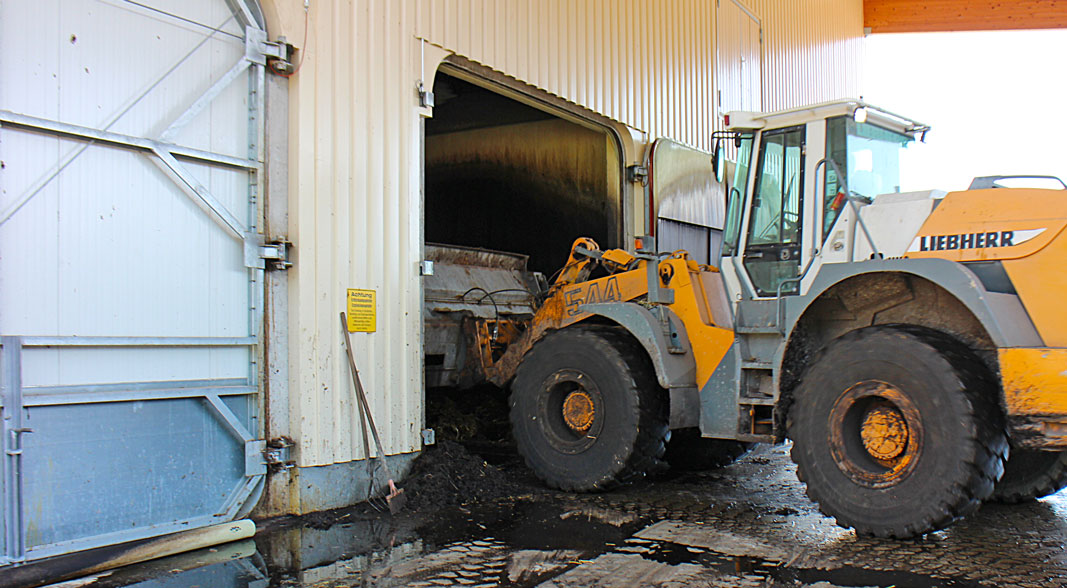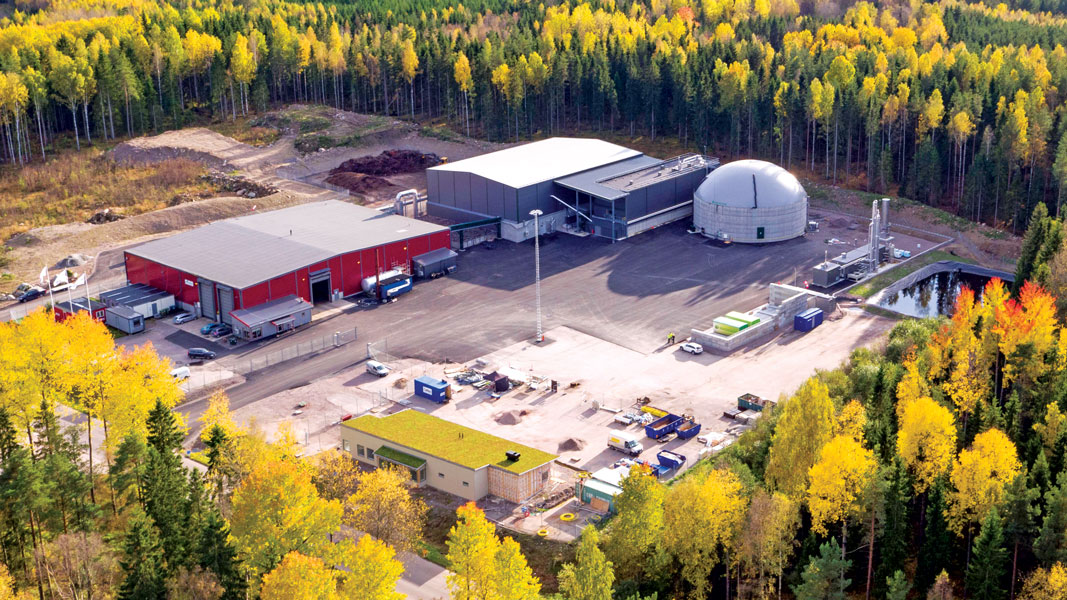Top: A high solids anaerobic digestion plant in Forsbacka, Sweden was integrated into an existing in-vessel composting facility to serve the Gävleborg region. Photo courtesy of Robin Szmidt, Target Renewables, Ltd.
Paula Luu
A growing volume of postconsumer organic waste is entering downstream processing infrastructure, often including food-contact compostable packaging. That packaging can be a key vessel to divert more food waste to composting facilities. Ensuring compatibility between these materials and existing materials management systems is crucial to maximizing resource recovery and environmental benefits. While we know certified, food-contact compostable packaging containing food scraps can be properly recovered by composting facilities, some U.S. municipalities rely on anaerobic digestion (AD) for organic waste management. This prompts a crucial question: Can large-scale AD facilities in the U.S. also effectively handle compostable packaging?
To help answer this question, the Composting Consortium — a collaboration managed by the Center for the Circular Economy at Closed Loop Partners — conducted a study to assess the extent to which compostable packaging is currently processed within existing large-scale AD infrastructure in the U.S. The analysis, done in partnership with BioCycle Connect, LLC and Target Renewables, Ltd., was focused on those facilities that process hundreds to thousands of tons per day of organic waste. The team also analyzed European and United Kingdom (UK) markets that have created viable pathways to utilize AD infrastructure as an end-of-life option for postconsumer food waste and certain certified compostable packaging.
The U.S. Large-Scale AD Market
The findings of this study suggest that large-scale AD, in its current state in the U.S., may not be a suitable solution for processing food waste with compostable packaging. Several factors contribute to this limitation:
- Use of Wet Anaerobic Digestion: Most U.S. AD facilities utilize wet mesophilic systems that generally process feedstock with less than 15% solids content. These systems require feedstock to be a slurry with a smoothie-like consistency and operate at lower temperatures that are not ideal for breaking down compostable materials. Wet mesophilic AD is optimized for handling cellulosic feedstock — like manure, crop residue and biosolids — and can also process nitrogen-rich feedstocks like food scraps. Compostable packaging exhibits slower degradation at these lower temperatures and is often removed before entering the digester through depackaging — the mechanical process of separating organic matter from packaging.
- Depackaging Equipment Limitations: Existing mechanical depackaging technologies lack the ability to differentiate between various packaging materials. As a result, all packaging is removed from the AD process, whether it is compostable or conventional plastic, hindering the potential for certified food-contact compostable packaging, including liner bags, to enter the system and be effectively treated.
- Absence of End Markets: Even if compostable packaging partially breaks down in AD, the resulting digestate that is the byproduct of AD often lacks established end markets in the U.S., particularly for the additional fraction derived from compostable packaging. This absence of robust end markets creates a barrier to implementing AD as a solution to process these materials.

In bunker-style AD systems, higher solid feedstocks are placed into the digester tunnels with front-end loaders. Photos by Robin Szmidt
What Can Be Learned From European AD Markets?
While AD might not currently be a standalone solution in the U.S., Europe offers valuable insights for future development:
- Using Hybrid Anaerobic Digestion: European markets are initiating hybrid models that codigest food waste and compostable packaging. These models maximize biogas production and facilitate subsequent composting of the digestate, overcoming limitations of wet mesophilic AD systems. While these hybrid systems can have higher capital and operating costs, they demonstrate the potential for maximizing both the economic and environmental benefits of organic waste recycling.
- Creating Industry Collaborations: Strong partnerships among AD operators, composters and manufacturers are crucial in Europe. This collaboration fosters innovation in packaging design and pretreatment methods that align compostable packaging with AD recovery, ensuring smooth material flow and improving the entire organics management ecosystem. Supportive policies, including feedstock quality regulations and financial incentives for hybrid facilities, further incentivize adoption of these approaches.
- Establishing Digestate Standards: Unlike the U.S., the UK and the European Union have established regulatory standards for digestate produced via anaerobic digestion of food waste and other feedstocks. The standards benefit end market development, especially with regard to quality assurance. The UK’s PAS 110 digestate quality standard, for example, specifies that input materials (feedstock) shall be “source segregated biowastes and/or source segregated biodegradable materials.” By this definition, compostable packaging is an acceptable input to a PAS 110-certified process. However, if such materials remain visible in whole or in part in digestate after AD, or post-AD composting, they would be considered contaminants and likely cause the digestate to fail. A hybrid model with back-end composting facilitates completes disintegration and thus compliance with the standard.

At the hybrid AD and composting plant in Forsbacka, Sweden, digestate is dewatered and composted for 7 to 10 days then screened.
What Lies Ahead For AD Of Compostable Packaging In The U.S.?
Current limitations must be addressed, and lessons drawn from successful models abroad, before large-scale AD can be used to recover compostable packaging in the U.S. Unlocking its full potential will require the following:
- Rethinking Infrastructure Development: Exploring and investing in alternative AD systems like thermophilic or high solid anaerobic digestion (HSAD) is one pathway to a more flexible downstream organics system. The higher operating temperatures of thermophilic and HSAD systems are better suited for handling diverse organic feedstocks, including compostable packaging. The research team found six HSAD systems across the U.S., but none of them accept or process compostable packaging because of concerns about contamination.
- Developing End Markets: Robust end markets must be developed to capture the full value of digestate and create economic incentives for AD facilities to accept compostable packaging. This could involve exploring processes like composting, drying, pelletizing and nutrient extraction to create higher value soil amendment products from the digestate.
- Initiating Industry Collaborations: Fostering partnerships among stakeholders to drive innovation in packaging design, pretreatment methods and supportive policies can help advance the full potential of large-scale AD in the U.S. as one way to recover organics. This collaborative approach can pave the way for effective waste management solutions that integrate AD and composting for holistic and responsible processing of compostable packaging in the U.S.
By addressing these challenges and learning from successful models in Europe, large-scale AD can potentially become viable in the U.S., alongside composting and other distributed organics recovery solutions. This would not only prevent contamination of recycling streams and disposal of compostable packaging in landfills but also potentially increase the amount of nutrient-rich food scraps available for AD and composting, maximizing resource recovery and contributing to a more flexible and sustainable future for organics management. The full report on anaerobic digestion and compostable packaging is available from the Center for the Circular Economy at Closed Loop Partners.
Paula Luu is a Senior Project Director at Closed Loop Partners. She leads the firm’s Composting Consortium, a collaboration managed by the Center for the Circular Economy at Closed Loop Partners, which works closely with brands, composters and other key stakeholders to gather data that can inform the best path forward and drive value across the composting system. The Center for the Circular Economy (‘the Center’) is the innovation arm of Closed Loop Partners, a firm at the forefront of building the circular economy.













